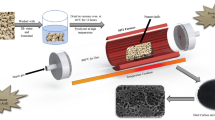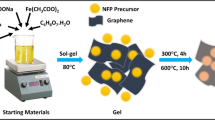Abstract
LiMn0.5Fe0.5PO4 cathode materials were prepared via a low-cost solid-state method and mixed with sucrose and then calcined at different temperatures. The structure, morphology, and electrochemical performance of the synthesized material were analyzed via X-ray diffraction, scanning electron microscopy-energy dispersive spectroscopy, high-resolution transmission electron microscopy, galvanostatic charge–discharge tests, cyclic voltammetry, and electrochemical impedance spectroscopy. The results showed that materials prepared via the solid-state method contained nanosized particles with a good olivine structure and exhibited excellent particle dispersibility at various sintering temperatures, resulting in high electrochemical performance. Moreover, at a high sintering temperature of 650 ℃, the battery material exhibited the highest conductivity and lithium-ion diffusion coefficient of 150.9 Ω and 2.15 × 10−5 S cm−1, respectively. The material featured a high discharge specific capacity of 110.0 mAh g−1 at a current density of 5 C owing to its good dispersion and regular spherical particle morphology obtained at 650 ℃. The electrochemical properties of battery materials were directly affected by the improvement and optimization of the parameters in the preparation process.







Similar content being viewed by others
Data availability
Not applicable.
References
Padhi AK, Nanjundaswamy KS, Goodenough JB (1997) Phospho-olivines as positive-electrode materials for rechargeable lithium batteries. J Electrochem Soc 144:1188–1194
Ao J, Wang X, Gao M, Wang J, Dong X (2018) Enhancement of electrochemical properties of niobium-doped LiFePO4/C synthesized by sol-gel method. J Chin Chem Soc 65:977–981
Cui Z, Guo X, Ren J, Xue H, Lu X (2021) Enhanced electrochemical performance and storage mechanism of LiFePO4 doped by Co Mn and S elements for lithium-ion batteries. Electrochimica Acta 388:138592
Wang HQ, Lai A, Huang D, Chu Y, Li Q (2021) Y-F co-doping behavior of LiFePO4/C nanocomposites for high-rate lithium-ion batteries. New J Chem 45:5695–5703
Yang J, Wang J, Tang Y, Wang D, Li X, Hu Y, Li R, Liang G, Sham TK, Sun X (2013) LiFePO4–graphene as a superior cathode material for rechargeable lithium batteries: impact of stacked graphene and unfolded graphene. Energy Environ Sci 6:1521–1528
Li Y, Wang L, Liang F, Yao Y, Zhang K (2021) Enhancing high rate performance and cyclability of LiFePO4 cathode materials for lithium ion batteries by boron doping. J Alloy Compd 880:160560
Saikia D, Deka JR, Chou CJ, Lin CH, Yang YC, Kao HM (2019) Encapsulation of LiFePO4 nanoparticles into 3D interpenetrating ordered mesoporous carbon as a high-performance cathode for lithium-ion batteries exceeding theoretical capacity. ACS Applied Energy Materials 2:1121–1133
Zhang X, Hou MM, Tamirate A, Zhu HH, Wang CC, Xia Y (2020) Carbon coated nano-sized LiMn0.8Fe0.2PO4 porous microsphere cathode material for Li-ion batteries. J Power Sources 448:227438
Hong J, Wang F, Wang X, Graetz J (2011) LiFexMn1-xPO4: a cathode for lithium-ion batteries. J Power Sources 196:3659–3663
Deng Y, Yang C, Zou K, Qin X, Zhao Z, Chen G (2017) Recent advances of Mn-Rich LiFe1-yMnyPO4 (0.5 ≤ y < 1.0) cathode materials for high energy density lithium- ion batteries. Adv Energy Mater 7:1601958
Trinh DV, Nguyen MTT, Dang HTM, Dang DT, Le HTT, Le HTN, Tran HV, Huynh CD (2021) Hydrothermally synthesized nanostructured LiMnxFe1-xPO4 (x = 0–03) cathode materials with enhanced properties for lithium-ion batteries. Sci Rep 11:12280
Damen L, Giorgio FD, Monaco S, Veronesi F, Mastragostino M (2012) Synthesis and characterization of carbon-coated LiMnPO4 and LiMn1-xFexPO4 (x= 0.2, 0.3) materials for lithium-ion batteries. J Power Sources 218:250–253
Hong J, Wang F, Wang X, Graetz J (2011) LiFexMn1−xPO4: a cathode for lithium-ion batteries. J Power Sources 196:3659–3663
Sin BC, Lee SU, Jin BS, Kim HS, Kim JS, Lee SI, Noh J, Lee Y (2014) Experimental and theoretical investigation of fluorine substituted LiFe0.4Mn0.6PO4 as cathode material for lithium rechargeable batteries. Solid State Ionics 260:2–7
Cheng G, Zuo P, Wang L, Shi W, Ma Y, Du C, Cheng X, Gao Y, Yin G (2015) High-performance carbon-coated LiMnPO4 nanocomposites by facile two-step solid-state synthesis for lithium-ion battery. J Solid State Electrochem 19:281–288
Xie Z, Chang K, Lia B, Tang H, Fu X, Chang Z, Yuan X, Wang H (2016) Glucose-assisted synthesis of highly dispersed LiMnPO4 nanoparticles at a low temperature for lithium ion batteries. Electrochim Acta 189:205–214
Cheng F, Wang W, Tan Z, Huang Y, Zhou H, Chen J, Zhang X (2011) High power performance of nano-LiFePO4/C cathode material synthesized via lauric acid-assisted solid-state reaction. Electrochim Acta 8:2999–3005
Pang J, Liu Y, Ye JV, Tang ZH, Wang J (2022) Microwave sintering of TiCN-based cermets prepared from electroless co-coated (Ti, W, Mo, V) CN powders. Rare Met 12:4209–4216
Zhang LL, Peng G, Yang XL, Zhang PC (2010) High performance LiFePO4/C cathode for lithium-ion battery prepared under vacuum conditions. Vacuum 84:1319–1322
Hong SH, Jin YM, Song MY (2014) Electrochemical properties of nano-cobalt powder prepared by chemical reduction with and without cetyltrimethylammonium bromide and carbon-coated at 500 °C for secondary lithium batteries. Met Mater Int 4:793–799
Guo SJ (1998) Powder sintering theory. Metallurgical Industry Press, Beijing, p 2
Li Y, Zhao H, Li BT, Huang H, Mao RZ (2015) Influence of sintering temperature and heating rate on particle size of ferrite powder. China Powder Technology 2:47–50
Chen SD, Chen JC, Lv LY, Feng J (2015) Study on preparation of LiFePO4 cathode materials by solid phase method. Thermal Processing 20:73–75
Ma GG (2001) Influence of sintering time on microstructure and properties of W-Ni-Fe heavy alloy. Weapon Mater Sci Eng 5:31–34
Li Y, Wang L, Liang F, Dai YN, Yao YC (2021) Effect of vacuum on the morphology evolution of LiMn0.2Fe0.8PO4 during synthesis and carbon coating process. Vacuum 192:110425
Zhang JX, Cao XW, Li XN, Li Y, Chen R (2008) Study on the carbonation of carbon source in the carbon coating treatment of LiFePO4. J Shanghai Univ Electr Power 24:172–177
Huang XP, Du YC, Qu PW, Liang F, Dai YN, Yao YC (2017) Effect of carbon coating on the properties and electrochemical performance of LiFePO4/C composites by vacuum decomposition method. Int J Electro chem Sci 12:7183–7196
Chen YQ, He HB, Liu C, Lu XH (2010) Thermal decomposition of glucose and sucrose by kinetics analysis. Chin J Process Eng 4:720–725
Huang XQ, Zhang PX, Xu QM, Li XY, Ren XZ, Luo ZK, Liu JH, Hong WL (2008) Effects of different carbon sources on properties of LiFePO4/C composites. Functional Materials 7:1154–1157
Cao YB (2010) Study on synthesis and modification of cathode materials for polyanionic iron-based Li-ion batteries. Central South University
Acknowledgements
The authors thank the Hebei Normal University for Nationalities, Chengde, Hebei Province, China, Kunming University of Science and Technology, Kunming, Yunnan Province, China.
Funding
This work is financially supported by Science and Technology Project of Hebei Education Department (grant no. QN2022203), Natural Science Foundation of China (grant no. 52064031), Self Financing Project of Chengde Science and Technology Plan (grant no. 202201A062).
Ethics declarations
Ethics approval
Not applicable.
Conflict of interest
The authors declare no competing interests.
Additional information
Publisher's note
Springer Nature remains neutral with regard to jurisdictional claims in published maps and institutional affiliations.
Rights and permissions
Springer Nature or its licensor (e.g. a society or other partner) holds exclusive rights to this article under a publishing agreement with the author(s) or other rightsholder(s); author self-archiving of the accepted manuscript version of this article is solely governed by the terms of such publishing agreement and applicable law.
About this article
Cite this article
Wang, L., Sun, Y., Li, Y. et al. Effect of sintering temperature on the morphology and electrochemical properties of LiMn0.5Fe0.5PO4/C synthesized via solid state method. Ionics 29, 4519–4526 (2023). https://doi.org/10.1007/s11581-023-05176-8
Received:
Revised:
Accepted:
Published:
Issue Date:
DOI: https://doi.org/10.1007/s11581-023-05176-8




